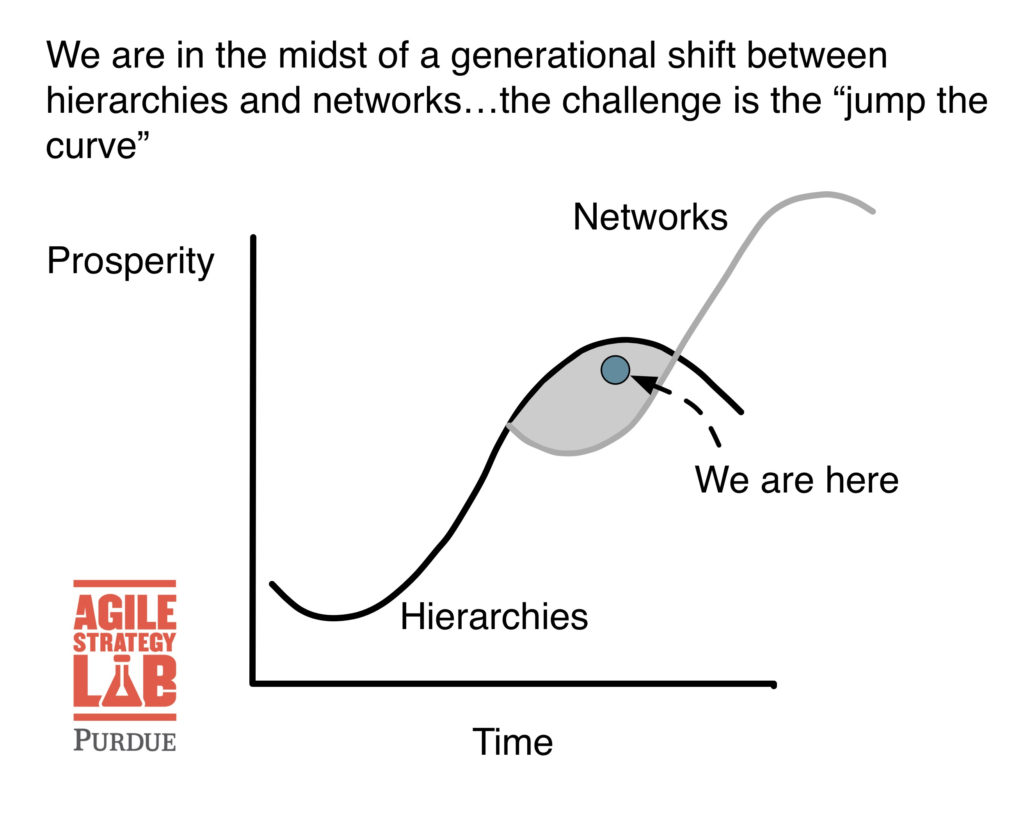What is Strategic Diversity Within a Team?
We start with a simple set of propositions:
- Designing and executing a complex strategy requires a diverse set of skills that rarely, if ever, reside in any single person.
- A strategic transformation – accelerating growth or innovation, launching new products, introducing new technologies, forming new partnerships, moving to what’s next — requires a team of people, working together, toward a shared future.
- Diversity within the team matters – diversity of thought, experiences, and ways of working. Effective teams need individuals who see the world differently. Each individual is most effective in distinct stages of strategy development and execution.
- These stages represent an “S-Curve” of incubation, rapid growth, maturity, and decline. Agile, effective teams make rapid adjustments across this S-Curve and use their knowledge of this sequence to decide when to undertake a new strategic direction.
A partnership forms
Last year, we began partnering with a Europe-based Human Insight, Ltd. and learned about their remarkable research in the field of strategic diversity. Based on the work of Dutch psychiatrist Peter Robertson and colleagues, Human Insight has developed the AEM-Cube, an assessment tool that provides insights into strategic diversity and how people can optimally contribute to it.
 Over the last 25 years, Human Insight and their partners have deployed the AEM-Cube among hundreds of organizations and thousands of individuals in Europe. They are continuously researching and developing its empirical, theoretical and statistical foundations.
Over the last 25 years, Human Insight and their partners have deployed the AEM-Cube among hundreds of organizations and thousands of individuals in Europe. They are continuously researching and developing its empirical, theoretical and statistical foundations.
The Lab is partnering with Human Insight to bring the AEM-Cube assessment to the U.S. We are leading joint workshops and events that will provide these insights to U.S. leaders facing strategic transformations.
What is strategic agility?
Human Insight has found that successful organizations and communities are able to recognize potential new S-Curves and “jump” from one to another. This move from one S-Curve to another can be tumultuous. When the shift is underway, conversations about “change,”“transformation,” and “strategy” begin to occur.
Individuals typically make their most valuable contributions at a specific spot on that S-Curve. The AEM-Cube assessment plots individuals and groups along the S-Curve. This assessment offers powerful insights into how teams can manage these these transitions most productively.
What does AEM-Cube measure?
The acronym “AEM” is a derived from the methodology’s three core dimensions – Attachment, Exploration, and Management. The ‘Cube’ in the name refers to the fact that these dimensions can be portrayed in a three-dimensional space. Using these three dimensions, Human Insight provides a visual representation of the diversity within the team:
- Attachment: this dimension focuses on the aspect of strategic transformation to which an individual’s performance optimally contributes. Is a person more attached to people (“with whom do I work?”) or attached to the tools and technologies for how they get things done (“how I do what I do?)
- Exploration: this dimension describes the stage of strategic transformation to which an individual’s performance optimally contributes. That is, do these contributions fall along the earlier stages of the S-curve or the later stages?
- Management: this dimension provides insights into the perspectives with which individuals make their contribution. Does a person tend to focus on the stage of strategic transformation to which they optimally contribute, or do they take an integrative, systems approach to the wider aspects of all stages of strategic transformation?
Who can benefit from a strategic diversity assessment?
Any team facing a transformation can benefit from a Strategic Diversity Assessment. This includes innovation teams, management and executive teams, teams involved with mergers and acquisitions, boards of directors, and teams of public officials designing or executing complex collaborations. Based on Robertson’s experience in Europe, some organizations find an enterprise-wide assessment to be of great benefit in organizing internal teams.
How does a strategic diversity assessment work with Strategic Doing?
The Strategic Diversity Assessment is an insightful companion to the agile disciplines of Strategic Doing. The assessment helps individuals better understand their unique contributions toward the agile strategies being designed and guided using Strategic Doing.
Can we learn and administer AEM-cube on our own?
Yes, the Purdue Agile Strategy Lab offers certification in Strategic Diversity, and through its partnership with Human Insight, Ltd also offers certification for administering the AEM-Cube. Certification equips individuals to lead workshops and administer the instrument in their own organizations.
How do we find out more?
Whether you are interested in having the Purdue Agile Strategy Lab lead a Strategic Diversity Assessment workshop or in becoming a certified AEM-cube administrator and Strategic Diversity Assessment Workshop Leader, you can check out our website to learn more. Your next step is to contact us to discuss a customized solution that will work best for you.
Contact
Scott Hutcheson, Deputy Director Purdue Agile Strategy Lab
1201 West State Street
West Lafayette, IN 47907

The Founder of the Lab at UNA and co-author of Strategic Doing: 10 Skills for Agile Leadership, Ed’s work has focused on developing new models of strategy specifically designed to accelerate complex collaboration in networks and open innovation. He is the original developer of Strategic Doing.
